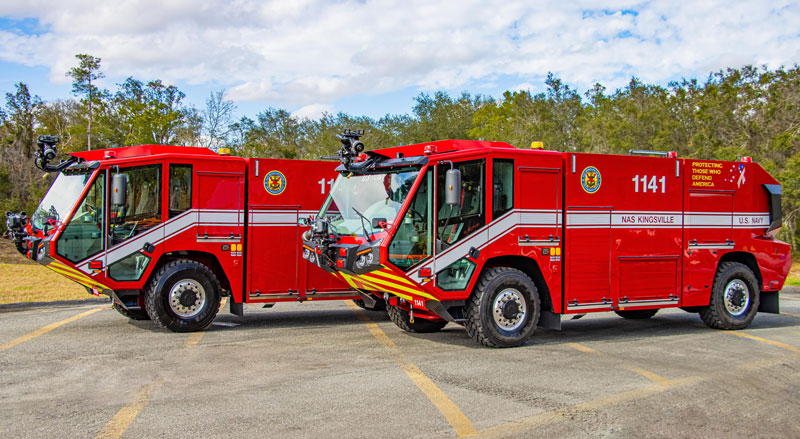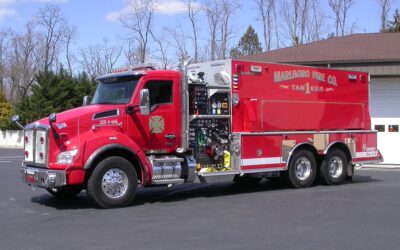The U.S. Navy Fire & Emergency Services has taken delivery of the first two reduced-size TITAN® ARFF 4×4 AT (air transportable) aircraft rescue and firefighting (ARFF) trucks made by E-ONE as part of a nine TITAN ARFF truck order.
Carl Glover, director of the Navy’s Fire & Emergency Services Installation Command, says these first two E-ONE TITAN ARFF trucks will be housed at Naval Air Station (NAS) Kingsville, Texas, a pilot training base 50 miles southwest of Corpus Christi. He notes that of the remaining seven trucks to be delivered from the order, Kingsville will get another one; two will go to Joint Base (JB) Anacostia-Bolling in Washington, D.C.; two to U.S. bases in Japan; and two to bases in Florida.
“The Navy has been looking for a smaller ARFF truck for some of its smaller airfields that handle smaller aircraft, many of which have older fire stations where a 1,500-gallon ARFF 4×4 truck would not fit,” Glover points out. “We looked at the TITAN ARFF 4×4 AT (air transportable) that E-ONE produced for the U.S. Air Force, which can be transported on C5, C17 and C130 aircraft, but the 1,500-gallon water tank still made it too large for us.”

Glover continues, “We got together with E-ONE and their reps to talk about modifications that could be made to the TITAN ARFF 4×4 in terms of height, length, and weight in order to fit in our stations, and we came up with a reduced-size TITAN ARFF 4×4 AT that fits our needs.”
Zach Schultz, government sales manager for the REV Fire Group, says the ARFF trucks are built on the E-ONE TITAN ARFF 4×4 AT chassis and cab, powered by a 500-horsepower (hp) Cummins X12 engine, and an Allison 4000 EVS automatic transmission that allows the truck to reach a maximum speed of more than 70 miles-per-hour.

Wheelbase on the ARFF 4×4 is 177 inches; overall length is 27 feet, 7 inches; and overall height is 10 feet. The truck has a Hendrickson Air Ride suspension, a Ward No Smoke 2 exhaust system, and disc brakes on the front and rear axles.
The Navy’s reduced size TITAN ARFF 4×4 AT trucks have an aluminum roll cage design featuring seating for three personnel with an ergonomic layout of all firefighting and operational functions, Schultz notes, with the driver occupying a position offset from center toward the driver’s side. The driver is in an air ride seat, and the firefighters are in self-contained breathing apparatus (SCBA) seats, he adds, and a medical cabinet is included in the cab layout.

The E-ONE TITAN ARFF 4×4 AT trucks for the Navy have Darley PSP 1,500-gallon-per-minute (gpm) single-stage pumps, 1,000-gallon polypropylene water tanks, and 140-gallon polypropylene foam tanks. Schultz points out that the rigs have a water tank with 500 gallons less than a typical ARFF 4×4 AT, which earned them the reduced size designation.
Schultz says each new ARFF trucks has a roof turret with a 12-volt Akron StreamMaster II 3482 electronic monitor that can flow 375/750 gpm through a nonaspirating Akron 5177 nozzle and a bumper turret with a 12-volt Akron StreamMaster II 3482 flowing 375/750 gpm through a nonaspirating Akron 5177 nozzle. Both monitors are controlled by an Akron multifunction joystick.

Schultz points out that the ARFF trucks have an ECOLOGIC® test port that allows Navy personnel to perform foam testing without actually flowing foam and still be sure they are flowing the correct percentages and gallonages. He adds that each of the reduced-size TITAN ARFF 4×4 AT units has four storage compartments on each side of the rigs that provide more than 150 cubic feet of usable storage capacity. He says the rigs each have a transverse compartment for storing a Little Giant ladder, 8-foot and 6-foot pike poles, four SCBA, and a preconnect with a polypropylene tray for hose.
Dan Gaumont, Navy Fire & Emergency Services fire apparatus specialist, says the Navy and personnel at NAS Kingsville “are very happy with the two reduced-size E-ONE TITAN ARFF 4×4 AT trucks. They’ve proven to be very much a rapid response type vehicle and are very well built.”
ALAN M. PETRILLO is a Tucson, Arizona-based journalist, the author of three novels and five nonfiction books, and a member of the Fire Apparatus & Emergency Equipment Editorial Advisory Board. He served 22 years with the Verdoy (NY) Fire Department, including in the position of chief.






